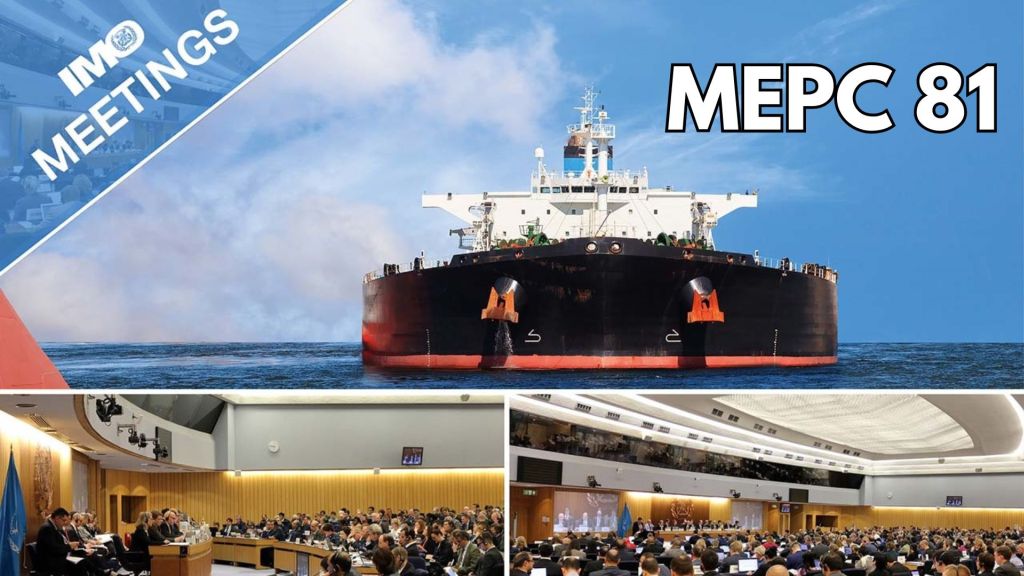
(www.MaritimeCyprus.com) MEPC 81 agreed that the discussions to set up technical and economic mid-term measures to implement the Strategy will be developed through different channels. A dedicated GESAMP working group was established to provide best possible scientific and technical assessment of issues related to the implementation of LCA Guidelines. A GHG Expert-Workshop will lead the following works on the basket of mid-term measures (modeling the collecting and the distribution of revenues) in line with the CIA task force “without engaging policy discussions”. An outline of the “IMO net-zero framework” was drafted to integrate possible amendments to MARPOL Annex VI (new Chapter 5).
MEPC 81 adopted:
- Amendments to Ballast Water Management Convention regarding the use of electronic water record books
- Amendments to MARPOL Protocol I Article V for the reporting procedures of lost containers
- Amendments to MARPOL Annex VI on low-flashpoint fuels and other fuel oil related issues; marine diesel engine replacing a steam system; accessibility of the data in the IMO Ship Fuel Consumption Database (IMO DCS) ; inclusion of data on transport work and enhanced level of granularity in the IMO DCS. Consequential amendments to SEEMP 2022 Guidelines.
- Draft amendments to the 2021 Guidelines on the shaft/engine power limitation system to comply with the EEXI requirements and use of a power reserve
- Amendments to the unified interpretations of regulations 2.2.15 and 2.2.18 of MARPOL Annex VI
- Amendments to circular BWM.2/Circ.43/Rev.1 on the approval process for the modifications of a system that has already received type approval
- Interim guidance for ports with challenging water quality
- BWM.2/Circ.82 on Guidance for the temporary storage of treated sewage and/or grey water in ballast tanks
- Circular on recommendations for the carriage of plastic pellets by sea in freight containers
MEPC 81 approved:
- Designation of ECAs in the Canadian Arctic waters and the Norwegian Sea, for adoption at MEPC 82.
- An action plan to address barriers to the uptake of the Guidelines on reduction of underwater noise from shipping (MEPC.1/Circ.906) with an experience-building phase set to three years, up to 2026.
MEPC 81 discussed the following matters:
- Ballast Water Management Convention Review
- Regulations on Black Carbon emissions from international shipping impacting the Arctic, for consideration at MEPC 82
- Guidance on the carriage requirements of biofuels and biofuel blends by bunker vessels, for consideration by ESPH group
- Guidance for the use of biofuels and biofuels blends, for consideration at MSC 108
- Guidance on consistent reporting of VLSFO, ULSFO, biofuels and e-fuels to the IMO DCS, for consideration at MEPC 82
A summary of the outcome is given hereunder for your information.
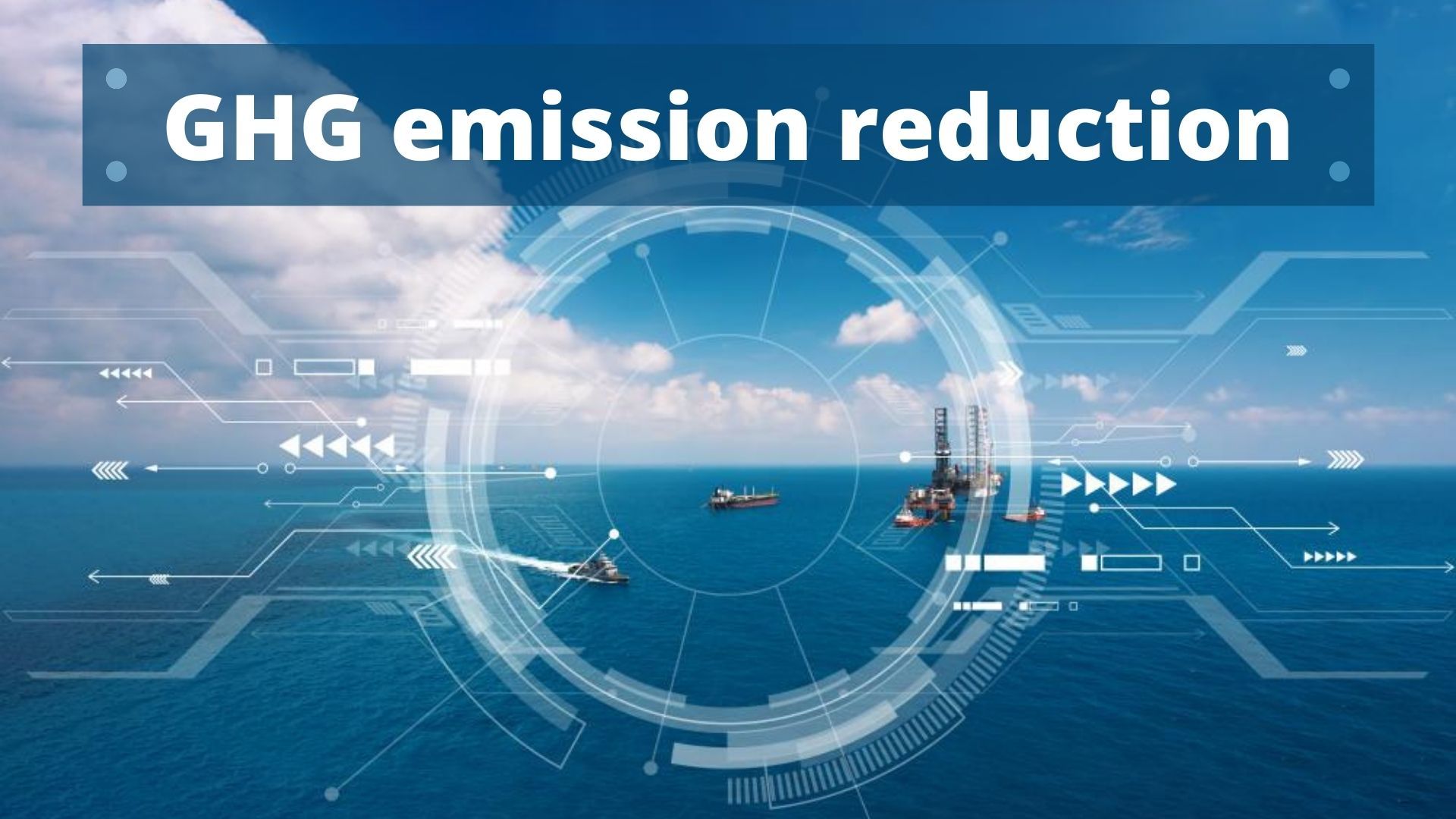
1. Greenhouse Gases (GHG)
At MEPC 80 held in July 2023, the 2023 IMO Strategy on Reduction of GHG Emissions from Ships (2023 IMO GHG Strategy) was adopted, reinforcing the levels of ambition for reducing GHG emissions from international shipping. At this session at MEPC 81, measures already in force such as the Data Collection System for fuel oil consumption of ships (IMO DCS), Energy Efficiency Existing Ship Index (EEXI) and Carbon Intensity Indicator (CII) regulations were reviewed along with discussions on mid-term measures and lifecycle assessments of marine fuels with an aim to achieve the reinforced levels of ambition.
1.1 Review of Data Collection System for fuel oil consumption of ships
The IMO DCS, under which operational data such as fuel oil consumption has been collected and reported since 2019, has been under review since 2022 to improve the items to be reported and the granularity of reported data. At MEPC 80, draft amendments to Appendix IX of MARPOL Annex VI were approved, amending/adding the items required to be reported in the IMO DCS. At this session, the draft amendments approved at MEPC 80 were adopted, introducing the new items to be additionally reported such as total fuel oil consumption per combustion systems and total fuel oil consumption while the ship is not under way. (See Section 4.1 below for details.)
In addition, following the discussions on the definitions of the terms and measurements methods for the new items to be reported, the amendments to the relevant IMO SEEMP (Ship Energy Efficiency Management Plan) Guidelines were adopted, comprising the details of “total transport work” calculated based on actual cargo carried during a voyage, etc.
1.2 Power Limitations in EEXI regulations
At this session, as a measure to facilitate the compliance with the EEXI regulations which started from 2023, the Guidelines on the Shaft / Engine Power Limitation System to Comply with the EEXI Requirements and Use of a Power Reserve was reviewed. As a result, a clarification in the guidelines was made to allow for pre-emptive un-limiting of the Shaft Power Limitation (SHaPoLi) or Engine Power Limitation (EPL) system under certain scenarios which may endanger the safe navigation of the ship, and also new functional requirements were added for SHaPoLi systems, the control of which is independent from the engine automation.
1.3 Heavy load carriers
The amendments for the Unified Interpretations to MARPOL Annex VI were approved, defining heavy load carriers which are exempted from the application of Energy Efficiency Design Index (EEDI), EEXI and CII regulations.
1.4 Mid-term measures for reduction of GHG
As mid-term measures to achieve the GHG reduction targets in international shipping, a basket of candidate measures, comprised of both a technical element and an economic element, is being developed as set out in the 2023 IMO GHG Strategy. Various measures have been proposed so far, such as: for a technical element, a goal-based marine fuel standard regulating the phased reduction of GHG intensity (GHG Fuel Standard); and for an economic element, posing a levy against GHG emissions (Universal Mandatory GHG Levy) and a combination of posing a fee to ships operating on fossil fuels and rebating revenues to ships operating on zero-emission fuels (feebate), etc. The following work plan has been agreed for developing mid-term measures, aiming for entry into force by 2027:
| Timeline | Work item |
| 2023-2024 | Conduct a comprehensive impact assessment (CIA) to assess potential impacts towards various countries and international shipping 2025 posed by combinations of respective basket of measures, and finalize the mid-term measures |
| 2025 | Approval and adoption of the mid-term measures |
| 2027 | Entry into force of the mid-term measures |
At this session, as a result of an exchange of views on the basket candidate of measures, the IMO net-zero framework was agreed, illustrating an outline of amendments to be considered, such as attained GHG fuel intensity and distribution of revenue etc. The IMO Member States and International Organizations were then invited to continue with discussions towards finalizing mid-term measures on the basis of the IMO net-zero framework.
Furthermore, the progress of the CIA was reported by the leading organizations of the tasks such as UNCTAD, where final reports will be expected by around this July. In addition, it was also agreed to organize an expert workshop prior to MEPC 82 to facilitate the understanding of preliminary findings of the CIA.
1.5 Operationalization of the Guidelines on Life Cycle GHG
Intensity of Marine Fuels For low/zero-carbon fuels, such as hydrogen, ammonia and biomass-based fuels which are expected to become more widely used in the future to decarbonize ships, it has been recognized that GHG emissions during manufacturing and distribution processes of these fuels should be taken into account. It is also recognized that GHG other than CO2, such as methane (CH4) and nitrous oxide (N2O), may cause significant impact on global warming.
At the previous session, the LCA Guidelines was adopted, which provides a general framework on the calculation method of GHG emission intensity (GHG emitted per unit energy) throughout the lifecycle of the fuel: from feedstock extraction/ cultivation to fuel production, distribution and fuel utilization onboard a ship. At the Correspondence Group established at the previous session, discussions were made on the review of the data collection template for establishing default emission factors, examination of proposed default emission factors, leakage of carbon and methane resulting from the LUC (Land-Use Change), credits from use of captured CO2 as carbon stock to produce synthetic fuels, credits from onboard carbon capture and storage etc.
At this session, on the basis of the draft amendments proposed by the Correspondence Group, the amendments (the detailed evaluation method and quantification of parameters for emissions from biofuel production, GHG emission intensity for electricity used during fuel production, evaluation method for GHG emissions onboard ships, etc.) to the LCA Guidelines were made and adopted as the 2024 LCA Guidelines.
Furthermore, as the issues investigated at the Correspondence Group were diverse and required expertise, it was agreed to newly establish a Working Group on the Life Cycle GHG Intensity of Marine Fuels under GESAMP to pursue discussions along with its Terms of Reference.
1.6 Onboard Carbon Capture Systems
There have been initiatives undertaken to develop onboard carbon capture (OCC) technologies for reducing GHG emissions by segregating and capturing CO2 from exhaust gases onboard ships. At the last session, a new output under Intersessional Working Group on Reduction of GHG from Ships (ISWG-GHG) was agreed for developing a regulatory framework.
At this session, it was agreed to develop, at the newly established Correspondence Group, a detailed work plan for developing a framework to regulate OCC technologies.
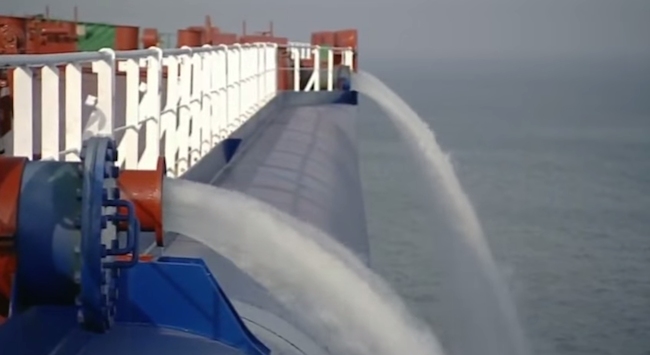
2. BWM Convention
2.1 Review of BWM Convention
When BWM Convention entered into force in 2017, it was agreed to monitor the application and to review the effectiveness of the Convention through the experience building phase (EBP), and MEPC at its previous session approved the Convention Review Plan (CRP) which comprises the list of issues that need to be finalized. The requirements in the current Convention were reviewed by the relevant Correspondence Group, and this session endorsed the list identifying items that need to be amended within the BWM Convention, BWMS Code and relevant guidelines and guidance.
The aforementioned list comprises survey aspects such as sampling and analysis of ballast water to confirm the treatment capacity and discharge concentration of active substances during intermediate and renewal surveys, in addition to commissioning tests, to ensure appropriate installation and effective operation etc. In addition, it was further agreed to reestablish the Correspondence Group for pursuing the topics that require further discussions.
2.2 Ballast water management in ships operating in challenging water quality
In response to the issues with difficulties in continuous operation of ballast water treatment systems (BWMS) at ports with challenging water quality (CWQ), discussions have been made with a view to developing a guidance for operations at such areas. At this session, an interim guidance was adopted, which provides operational guidance such as determination of CWQ, bypass procedures for ballasting operations at ports with CWQ and decontaminating procedures of ballast tanks after the bypassed ballasting operation.
2.3 Temporary storage of treated sewage and/or grey water
Discharge of treated sewage and grey water has been prohibited in certain ports, which led to discussions for developing guidance for temporary storage of treated sewage and/or grey water to ballast tanks in such ports. At this session, the guidance for temporary storage of treated sewage and grey water was approved. The guidance sets out the standards such as for flushing tanks after temporary storage and for implementing the relevant procedures in Ballast Water Management Plans (BWMP).
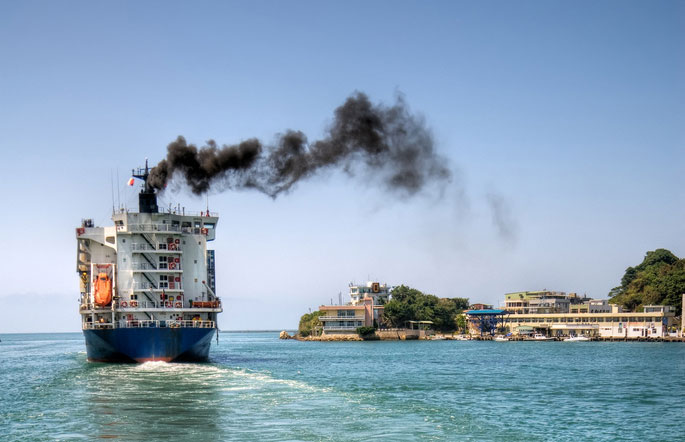
3. Air pollution prevention
3.1 Designation of NOx and SOx Emission Control Areas
Regulation 13 of MARPOL Annex VI specifies the Nitrogen Oxides (NOx) emission standards for marine diesel engines installed on board ships. Regulation 13.6 designates the North American area, the US Caribbean Sea area, Baltic Sea area and North Sea area as NOx Emission Control Areas (NOx ECA), in which the NOx Tier III emission limit is applied.
Regulation 14 of MARPOL Annex VI sets out control measures to reduce emissions of Sulphur Oxides (SOx) and Particulate Matter (PM) from ships, where the sulphur content in fuel oil used has been generally limited to 0.50% since 2020.
Regulation 14.3 designates the Baltic Sea area, North Sea area, North American area, United States Caribbean Sea area and Mediterranean Sea area as SOx Emission Control Areas (SOx ECA), in which the sulphur content in fuel oil used is further limited to 0.10%.
At this session, proposals were submitted to newly designate Canadian Arctic ECA and Norwegian Sea ECA as NOx ECA and SOx ECA. As a result, draft amendments to MARPOL Annex VI were approved, adding these areas to NOx ECA and SOx ECA.
Given that the draft amendments will be adopted at MEPC 82, the sulphur content in fuel oil used for ships operating in these areas will be limited to 0.10% at the earliest on or after March 2027. Furthermore, the NOx Tier III emission limit will be applied to the following ships operating in these waters and areas.
Canadian Arctic NOx ECA
|
Norwegian Sea NOx ECA
|
3.2 Effectiveness of measures against NOx reduction regulations
While Selective Catalytic Reduction (SCR) or Exhaust Gas Recirculation (EGR) systems are often chosen as solutions for complying with NOx regulations, the effectiveness of such systems are being questioned for cases such as when ships operate under low loads in ECA, where the exhaust gas temperature becomes low or auxiliary control device (ACD) becomes activated and hence the system is prevented from functioning properly.
In this regard, it was proposed to examine the way forward to improve the effectiveness of the NOx regulations as well as its application for ships operating in ECA based on the date of keel laid. At this session, shortcomings of the current NOx regulations such as above were identified, and it was agreed to continue the discussion at MEPC 82.
3.3 Measures to enhance the safety of ships relating to the use of fuel oil
Triggered by the control measures to reduce emissions of SOx and PM, further measures to enhance the safety of ships related to the use of fuel oil have been discussed. The 107th session of the Maritime Safety Committee (MSC 107) held in June 2023 approved and further requested MEPC to approve the draft joint MSC-MEPC guidelines for taking fuel oil samples during bunkering based on the existing guidelines (Res. MEPC.182(59)) in order to establish a unified sampling regime under both the SOLAS and MARPOL Conventions.
At this session, the draft joint guidelines was reviewed to align the terminologies between the guidelines and the MARPOL Convention etc., and the amended draft joint guidelines was subsequently approved. The draft revised guidelines will be requested for approval by the subsequent MSC session and will be published as an MSC-MEPC Circular upon approval.
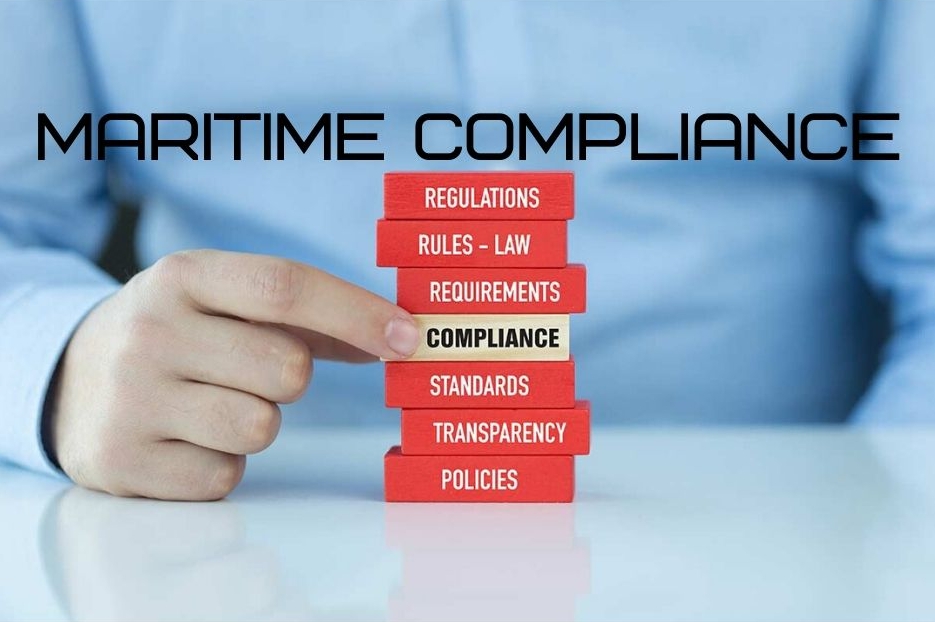
4. Amendments to mandatory instruments
MEPC 81 adopted amendments to mandatory instruments as follows:
4.1 Review of Data Collection System for fuel oil consumption of ships
The amendments to Appendix IX of MARPOL Annex VI were adopted, including the amendments and additions to the following items required to be reported in the DCS.
- Total fuel oil consumption per combustion systems (main engines, auxiliary engines/generators and oil-fired boilers).
- Total fuel oil consumption while the ship is not under way.
- Laden distance traveled (on a voluntary basis).
- Transport work.
- Total amount of on-shore power supplied.
- Category of Innovative energy efficiency technologies.
Entry into force: 1 August 2025
The Parties were further invited to consider early application of the amended data collection provisions from 1 January 2025.
4.2 Revision of the requirements of bunker delivery note for low-flashpoint fuels and gas fuels
The amendments to MARPOL Annex VI were adopted, which clarify the requirements for onboard storage and minimum information of BDN for low-flashpoint fuels and gas fuels.
Entry into force: 1 August 2025
4.3 Ballast Water Record Books in electronic record book format
The amendments to the Regulations A-1 and B-2 of the BWM Convention were adopted, which include the reference to “the Guidelines for the use of electronic record books under the BWM Convention” adopted at MEPC 80.
Entry into force: 1 October 2025





